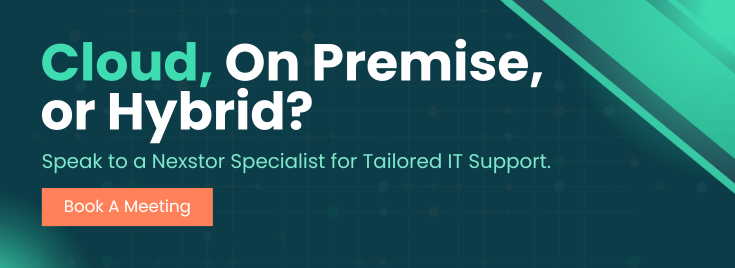In this week’s guest post, Kaminario’s Julie Pike explores how to improve business agility and the issues with on-prem IT and legacy IT infrastructures. The full article is below as well as a link to the original at the bottom of this blog.
Are you looking for a way to reduce business risk, increase your revenue growth, and keep costs under control? The key to making all of these happen is to improve your business’s agility—your ability to quickly and effectively respond to trends and business changes. But your current technology setup may be holding you back. Let’s take a look at how the technology that powers your business may be preventing you from achieving the level of agility you need to be competitive.

Tech setup: On-prem/legacy apps
If you’re still running your business’s mission-critical applications on legacy or on-prem systems, there are many factors that could be impeding your agility, including:Siloed data
With critical data trapped in a siloed, complex legacy infrastructure, it’s hard for your business to move quickly; a seemingly simple request can quickly turn difficult when dealing with data that is stovepiped into single application stacks. Siloed data creates a negative domino effect on your business, slowing your development capabilities and significantly increasing the necessary time-to-market for any new business initiatives. This, in turn, can cause you to miss your growth and revenue targets, further impacting your business.Poor UX
Another impact that legacy systems can have on your business’ agility is that of a poor user experience. Issues with performance are likely to frustrate not just employees but also customers, who may end up taking their business elsewhere and spreading the word about their maddening experience. For ecommerce businesses, lost order transactions and abandoned shopping carts may, unfortunately, become the norm as your technology continues to deliver less-than-stellar performance.Unable to support business dynamics
To be agile, your business must be capable of constantly changing—everything from new SLAs and new projects to new customer requirements and new initiatives. But if you’re stuck in an on-prem environment, reacting and responding to these changes is no easy feat. You need to have enough hardware capacity and performance to cover your peak needs, but you don’t want to overprovision resources and waste money. Figuring out the “perfect” amount of resources you’ll need can be a guessing game—not to mention time-consuming and expensive. The COVID-19 pandemic and resulting rise in employees working from home is a prime example of this. Kaminario is seeing skyrocketing interest across industries in remote working platforms, and increased demand for resources specifically among its healthcare and health tech customers. If you’re in a similar situation and still use a traditional on-prem environment, your only option to scale is to add hardware and software–but with supply chains disrupted, that may not be a possibility.Tech setup: public cloud applications
Moving your business-critical apps to the public cloud gives you more flexibility than an on-prem setup, but even there, agility issues are still present.Migration risks
Certainly, the cloud environment offers much more flexibility and potential for agility than on-premises environments. But the reality is that migrating your applications to the cloud is not a one-size-fits-all process. Migration projects tend to take longer than anticipated, and there’s always a certain level of risk that things will break and business will be impacted. Additionally, there’s no guarantee on a specific return on your investment; the inherent potential dangers that accompany any migration project mean that your business value may be unpredictable at best or completely unrealized at worse.Lock-in issues
To be truly agile, your business must have the ability to make technology decisions that best support your roadmap and revenue goals. But if you’re working with a public cloud provider, you likely have “flexibility” in name only. Certainly, you may want to take advantage of the offerings of another vendor, but once you’ve gone through the time and expense of refactoring your applications to perform on a specific cloud’s infrastructure, the thought of going through the process again is not realistic. Vendor lock-in—whether the vendor’s terms create the situation, or you simply have too much invested to move—is a real agility challenge.Cost issues
The Coronavirus and the global uncertainty around it is creating a number of business challenges as companies rush to scale while simultaneously trying to keep things “business as usual” with remote workers. And if you’re in a public cloud environment, you at least have the ability to spin up quickly to address this demand. But what you may not be ready for is the bill —all of this ramping up can come with a price tag you didn’t expect nor plan for.How to improve business agility using private clouds
Staying agile in today’s world is more important than ever. You need to be able to deal with the challenges of keeping remote workers connected, and adapting to this cultural and technical shift in a smooth and cost-effective way. As discussed in this article, legacy IT infrastructures are providing a barrier to ‘business as usual’. And with surprise price hikes a real possibility with public cloud providers, more businesses are looking for a private cloud solution to deliver the power, flexibility and agility of the cloud.Through Nexstor.Cloud‘s private cloud infrastructure, you have the control of on-prem without the capital expenditure of managing the IT infrastructure yourself. From a complete Managed IT service to delivering business-critical applications through Desktop-as-a-Service, Nexstor.Cloud provides businesses with the means for scaling their IT to meet the ever-changing demands of their daily operations and the needs of their customers.

